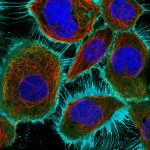Lien vers Pubmed [PMID] – 26725203
Curr. Biol. 2016 Jan;26(1):120-8
Phosphoinositide (PtdIns) homeostasis requires a tight spatial and temporal regulation during the endocytic process [1]. Indeed, PtdIns(4,5)P2 plays a crucial role in endocytosis by controlling clathrin-coated pit formation, whereas its conversion into PtdIns4P right after scission of clathrin-coated vesicles (CCVs) is essential for successful uncoating and cargo sorting [1-6]. In non-neuronal cells, endosomal PtdIns(4,5)P2 hydrolysis critically relies on the lipid phosphatase OCRL [7-9], the inactivation of which causes the Oculo-Cerebro-Renal syndrome of Lowe [10, 11]. To understand the coupling between PtdIns(4,5)P2 hydrolysis and endosome formation, a key issue is thus to unravel the mechanism by which OCRL is recruited on CCVs precisely after their scission from the plasma membrane. Here we found that the Rab35 GTPase, which plays a fundamental but poorly understood role in endosomal trafficking after cargo internalization [12-21], directly recruits the OCRL phosphatase immediately after scission of the CCVs. Consistent with Rab35 and OCRL acting together, depletion of either Rab35 or OCRL leads to retention of internalized receptors such as the endogenous cation-independent mannose-6-phosphate receptor (CI-MPR) in peripheral clathrin-positive endosomes that display abnormal association with PtdIns(4,5)P2- and actin-binding proteins. Remarkably, Rab35 loading on CCVs rapidly follows the recruitment of the AP2-binding Rab35 GEF/activator DENND1A (connecdenn 1) and the disappearance of the Rab35 GAP/inhibitor EPI64B. We propose that the precise spatial and temporal activation of Rab35 acts as a major switch for OCRL recruitment on newborn endosomes, post-scission PtdIns(4,5)P2 hydrolysis, and subsequent endosomal trafficking.
